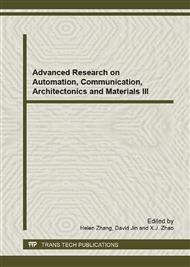[1]
C. V Burton, W. H Kirkaldy-Willis, K Yong-Hing, K. B Heithoff, Causes of failure of surgery on the lumbar spine. Clin Orthop. 157 (1981)191–199.
DOI: 10.1097/00003086-198106000-00032
Google Scholar
[2]
J Cauchoix, C Ficat, B Girard, Repeat surgery after disc excision. Spine. 3 (1978)256–259.
DOI: 10.1097/00007632-197809000-00011
Google Scholar
[3]
D Fiume, Treatment of the failed back surgery syndrome due to lumbo-sacral epidural fibrosis. Acta Neurochir (suppl). 64 (1995)116–118.
DOI: 10.1007/978-3-7091-9419-5_25
Google Scholar
[4]
M. S Abdou, R. W Hardy, Epidural fibrosis and failed back syndrome: history and physical findings. Neurol Res. 21 (S1) (1999)55–58.
DOI: 10.1080/01616412.1999.11758603
Google Scholar
[5]
R. W Hu, S Jaglal, T Axcell, G Anderson, A population-based study of reoperations after back surgery. Spine. 22 (1997)2265–2271.
DOI: 10.1097/00007632-199710010-00013
Google Scholar
[6]
H. R Silvers, Lumbar disketomy for recurrent disk herniation, J. Spinal Disord. 7 (1994)408–419.
Google Scholar
[7]
S. J Atlas, R. A Deyo, D. L Patrick, K Convery, Keller, D. E Singer, The Quebec Task Force classification for spinal disorders and the severity, treatment, and outcomes of sciatica and lumbar spinal stenosis. Spine. 21 (1996)2885–2892.
DOI: 10.1097/00007632-199612150-00020
Google Scholar
[8]
R. B North, J. N Campbell, C. S James et al, Failed back surgery syndrome: 5-year follow-up in 102 patients undergoing repeated operation. Neurosurgery. 28 (1991)685–690.
DOI: 10.1097/00006123-199105000-00008
Google Scholar
[9]
R Dullerud, V Graver, M Haakonsen, A. K Haaland, M Loeb, B Magnæs, Influence of fibrinolytic factors on scar formation after lumbar discectomy. A magnetic resonance imaging follow-up study with clinical correlation performed 7 years after surgery. Spine. 23 (1998).
DOI: 10.1097/00007632-199807010-00007
Google Scholar
[10]
J. S Ross, J. T Robertson, R. C Frederickson, Association between peridural scar and recurrent radicular pain after lumbar discectomy: magnetic resonance evaluation. ADCON-L European Study Group. Neurosurgery. 38 (1996)855–861.
DOI: 10.1097/00006123-199604000-00053
Google Scholar
[11]
Kakehi K, Kinoshita M, Yasued S-I, Hyaluronic acid: separation and biological implications, J. Chromatogr. 797(2003)347–355.
Google Scholar
[12]
Bulpitt P, Aeschlimann D, New strategy for chemical modification of hyaluronic acid: preparation of functionalized derivatives and their use in the formation of novel biocompatible hydrogels, J. Biomed. Mater. 47(1999)152–169.
DOI: 10.1002/(sici)1097-4636(199911)47:2<152::aid-jbm5>3.0.co;2-i
Google Scholar
[13]
Oerther S, Gall HL, Payan E, Lapicque F, Presle N, Hubert P, Dexheimer J, Netter P, Lapicque F, Hyaluronate–alginate gel as a novel biomaterial: mechanical properties and formation mechanism. Biotechnol. Bioeng. 63(1999)206–215.
DOI: 10.1002/(sici)1097-0290(19990420)63:2<206::aid-bit9>3.0.co;2-8
Google Scholar
[14]
Hu SG, Jou CH, Yang MC, Protein adsorption, fibroblast activity and antibacterial properties of poly (3-hydroxybutyric acid-co-3-hydroxyvaleric acid) grafted with chitosan and chitooligosaccharide after immobilized with hyaluronic acid. Biomaterials. 24(2003).
DOI: 10.1016/s0142-9612(03)00079-6
Google Scholar
[15]
N.V. Majeti, Ravi Kumar, A review of chitin and chitosan applications. Reactive and Functional Polymers. 46 (2000)1–27.
DOI: 10.1016/s1381-5148(00)00038-9
Google Scholar
[16]
Chaobo Xiao, Shanjun Gao, Heng Wang, Lina Zhang, Blend films from chitosan and konjac glucomannan solutions. Journal of Applied Polymer Science. 76 (2000)509–515.
DOI: 10.1002/(sici)1097-4628(20000425)76:4<509::aid-app8>3.0.co;2-2
Google Scholar
[17]
Sundararajan V. Madihally, Howard W.T. Matthew, Porous chitosan scaffolds for tissue engineering. Biomaterials. 20 (1999)1133–1142.
DOI: 10.1016/s0142-9612(99)00011-3
Google Scholar
[18]
Yong Zhang, Miqin Zhang, Microstructural and mechanical characterization of chitosan scaffolds reinforced by calcium phosphates. Journal of Non-Crystalline Solids. 282 (2001) 159–164.
DOI: 10.1016/s0022-3093(01)00345-3
Google Scholar
[19]
Jue-Yeon Lee, S.H. Nam, S.Y. Im, Y.J. Park, Y.M. Lee, Y.J. Seol et al. Enhanced bone formation by controlled growth factor delivery from chitosan-based biomaterials. Journal of Controlled Release. 78 (2002)187–197.
DOI: 10.1016/s0168-3659(01)00498-9
Google Scholar
[20]
N. Shanmugasundaram, P. Ravichandran, P. Neelakanta, Nalini Ramamurty, Subrata Pal, Panduranga Rao, Collagen–chitosan polymeric scaffolds for the in vitro culture of human epidermoid carcinoma cells. Biomaterials. 22 (2001) 1943–(1951).
DOI: 10.1016/s0142-9612(00)00220-9
Google Scholar
[21]
Kwunchit Oungbho, Bernd W. Müller, Chitosan sponges as sustained release drug carriers. International Journal of Pharmaceutics. 156 (1997)229–237.
DOI: 10.1016/s0378-5173(97)00201-9
Google Scholar
[22]
M. Zhang, X.H. Li, Y.D. Gong, N.M. Zhao, X.F. Zhang, Properties and biocompatibility of chitosan films modified by blending with PEG. Biomaterials. 23 (2002)2641–2648.
DOI: 10.1016/s0142-9612(01)00403-3
Google Scholar
[23]
Wen-yuan Chuang, Tai-horng Young, Chun-Hsu Yao, Wen-Yen Chiu, Properties of the poly(vinyl alcohol)/chitosan blend and its effect on the culture of fibroblast in vitro. Biomaterials. 20 (1999)1479–1487.
DOI: 10.1016/s0142-9612(99)00054-x
Google Scholar
[24]
S.G. Hu, C.H. Jou, M.C. Yang, Biocompatibility and antibacterial activity of chitosan and collagen immobilized poly(3-hydroxybutyric acid-co-3-hydroxyvaleric acid). Carbohydrate Polymers. 58 (2004)173–179.
DOI: 10.1016/j.carbpol.2004.06.039
Google Scholar
[25]
Bin Li, Bijun Xie, Synthesis and characterization of konjac glucomannan/poly(vinyl alcohol) interpenetrating polymer networks. Journal of Applied Polymer Science. 93 (2004)2775–2780.
DOI: 10.1002/app.20769
Google Scholar
[26]
Kang Wang, Zhimin He, Alginate-konjac glucomannan–chitosan beads as controlled release matrix. International Journal of Pharmaceutics. 244 (2002)117–126.
DOI: 10.1016/s0378-5173(02)00324-1
Google Scholar
[27]
Pathak, C. P., & Barman, S. P. (2003), Multiblock biodegradable hydrogels for drug delivery and tissue treatment. United States Patent. 6, 639, 014.
Google Scholar
[28]
Slepian, M. J., & Massia, S. P. (2001), Local polymeric gel cellular therapy. United States Patent. 6, 290, 729.
Google Scholar
[29]
R. Servaty, J. Schiller, H. Binder, K. Arnold, Int, J. Biol. Macromol. 28 (2001)121–127.
Google Scholar
[30]
E. Dřímalová, V. Velebný, V. Sasinková, Z. Hromádková, A. Ebringerová, Carbohydr. Polym. 61 (2005)420–426.
DOI: 10.1016/j.carbpol.2005.05.035
Google Scholar
[31]
X. Ye, J.F. Kennedy, B. Li, B.J. Xie, Condensed state structure and biocompatibility of the konjac glucomannan/chitosan blend films. Carbohydrate Polymers. 64(2006)532–538.
DOI: 10.1016/j.carbpol.2005.11.005
Google Scholar


